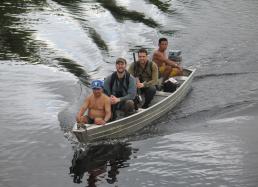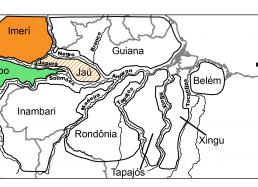Studying Bird & Parasite Diversity in the Brazilian Amazon
Amazonia is the largest, most diverse lowland rainforest on Earth. One tenth of the world’s plant and animal species live here, including one out of every five bird species. The vast diversity of Amazonian bird life is currently divided into just eight enormous Areas of Endemism—vast regions that harbor species found no where else on Earth.
However, some scientists have become concerned that these gigantic areas ignore the existence of smaller geographical pockets where populations are evolving in isolation. Studying the DNA of birds living in poorly explored sectors of Amazonia can help to identify more local regions of endemism and ensure that appropriate conservation actions are taken to protect them.
The Rio Japurá Expedition
In the summer of 2007, Field Museum ornithologists John Bates and Jason Weckstein spent a month traveling by boat to conduct a joint survey with Alexandre Aleixo, Curator of Birds at the Goeldi Museum in Brazil. Their goal was to launch the first in a series of expeditions funded by the National Science Foundation to catalog bird and parasite life in sections of the Amazonian wilderness where little biodiversity documentation had been done.
Their initial survey focused on the banks of the Rio Japurá, a remote tributary of the Amazon River that forms the boundary between two Areas of Endemism—the Napo and the Imerí. By cataloging species, collecting specimens, recording calls, and sampling the parasites and DNA of birds from tributaries along both sides of the Japurá’s banks, the team hoped to learn more about the evolution and distribution of the area's diversity.
Rewarding Discoveries
After returning home with their samples, the team began the process of analyzing DNA to study the genetic history of the specimens collected during the trip. Their ongoing research has revealed that, as anticipated, a number of bird populations once believed to be widely distributed members of the same species are actually genetically different, as are their parasites.
When the team then mapped the ranges of each genetically distinct population, they were able to confirm the existence of a localized pocket of endemism within the Imerí, something that had long been suspected by Brazilian scientists but never genetically confirmed. The wide expanse of water where the Rio Japurá meets the Amazon River (called the Rio Solimões at this point) had been acting as a barrier to interbreeding, forcing populations on opposite banks to evolve in isolation for hundreds of thousands of years. Having this newly identified region, known as the Jaú, formally acknowledge by conservationists will help safeguard its unique inhabitants.
Long-Range Goals
As the team conducts future expeditions within the Brazilian Amazon, they will continue to search for other unrecognized bird lineages and isolated hotspots of genetic diversity. Their goal is not only to chart the evolutionary history of Amazonian birds and the role that rivers play in spawning new species, but also to help conservationists reassess the current geographical boundaries of areas targeted for protection.
To learn more about Amazonian birds, explore the stories in "About the Expedition," and check out the photo galleries, videos, and blogs from the 2007 expedition. And stay tuned for more Brazilian bird-research expeditions soon!




